How product managers achieve stakeholder alignment
Last updated: April 2024
No one accomplishes great things alone. This is especially true for product managers. You rely on a variety of stakeholders within and outside the organization to build and deliver lovable products.
Depending on the size of your company and how people work together, you likely collaborate closely with company leaders as well as the cross-functional product team: your colleagues from engineering, UX, marketing, sales, and support. You might also interact with external stakeholders such as board members, investors, strategic partners, and flagship customers.
Of course, each of these stakeholder groups has its own priorities, concerns, and motivations. But garnering stakeholder buy-in is critical to your success as a product leader. In order to deliver real value to customers and the business, you need the support of the entire organization and community behind you. This requires that you include and engage the folks around you early and often — gathering insights and ensuring alignment throughout the product development process. Then, you can make more informed decisions, rally everyone around the success of your offering, and build a better product together.
Jump ahead to any section to learn more:
Map out stakeholder needs using the template below — with a free trial.

When should product managers reach out to stakeholders?
You know it is important to get alignment from stakeholders, but it can be challenging to know which decisions necessitate their involvement. Maybe you are not sure which leaders need to be involved at which stage in product planning. Or you are in a siloed organization where product management has not typically had a direct and frequent line of communication with customer-facing groups such as sales or support.
The reality is that every stakeholder group can offer a unique outlook to help you improve your offering — so it is essential to meet with and connect the dots among all the groups. This does not mean that stakeholders will dictate your decisions. Some might serve as influencers rather than decision makers depending on the context. Nonetheless, it is important to share details about your strategic direction and roadmap so that everyone in the organization can work toward creating a Complete Product Experience for customers.
In the table below, we outlined key activities during product development that benefit from stakeholder alignment — with our perspective on relevant stakeholders at each step. You will also find resources on how to gain this alignment within Aha! software.
Activity | Relevant stakeholders |
Read next: Aha! Roadmaps | Best practices for stakeholder alignment: Set product strategy | |
| |
Read next: Aha! Roadmaps | Best practices for stakeholder alignment: Prioritize the best ideas | |
Read next: Aha! Roadmaps | Best practices for stakeholder alignment: Create your product roadmap | |
Read next: Aha! Roadmaps | Best practices for stakeholder alignment: Communicate roadmap progress | |
Read next: Aha! Roadmaps | Best practices for stakeholder alignment: Manage product launches | |
|
Of course, you will need to determine the type and level of involvement at each stage that make the most sense for your organization. (Be sure to discuss and agree on this with stakeholders and document decisions in a centralized knowledge hub that everyone can refer to.)
Related:
What are the steps to achieve stakeholder alignment?
Alignment begins before you ever step into a meeting room or join a Zoom call. It starts with relationships, open communication, and preparedness. Each stakeholder needs to clearly understand the product vision and their department's role in making it a reality. It also helps to communicate the overall product development process that product, engineering, and related project and program management teams follow. This way, stakeholders understand how to submit product ideas, how those ideas make it to the roadmap, and how the team prioritizes what to build.
Each stakeholder meeting should include a meeting agenda — and the details on yours will vary. At a high level, we recommend the following approach:
1. Set a regular cadence
Whether you are meeting with a group or individual leader, level-set on how often you should meet and add a recurring meeting to the calendar. Having a predictable meeting cadence with stakeholders will help you align on the right level of granularity for your updates and feedback loops.
Each organization will be different, but here is an example of a basic cadence for roadmap progress:
Weekly roadmap reviews with product managers from across the product portfolio
Monthly reviews with cross-functional teams such as sales, support, and product platform
Quarterly reviews with external stakeholders or executives
2. Be open
You are an expert on your product. Maintaining that expertise requires staying open to others — great ideas can come from anywhere. So listen closely to stakeholder needs and be curious about their requests. If you are discussing a change to the roadmap (either something a stakeholder proposes or a proactive change you are making), be prepared to explain the "why" behind any decision. People will feel more satisfied with a "no" if they understand there is a good reason for it.
3. Document agreement
Record what everyone decided in the meeting and what will happen next. This will help all parties feel secure in the plan and prevents folks from losing sight of what you agreed on. Not immediately sure of the next steps? That is OK — but do not forget to create a timeline of when you will know.
4. Adjust and move forward
If decisions you make during the meeting warrant updating the product plan, be sure to communicate with the folks involved and update the plan in your roadmapping tool. Giving the team access to the latest information builds trust and helps ensure that people understand what they are working on next (and why).
Related:
5 quick tips for better alignment
We recognize that even if you follow the right steps or processes, stakeholder collaboration can be fraught. Big personalities, strong opinions, and different vantage points within the organization: These can all make for very challenging conversations.
This is why leading with strategy is so critical. When you have a clearly defined product vision and a strategy that supports it, conversations are grounded in purpose and direction — keeping the focus on what will bring real value your to customers.
Additional approaches that we find helpful include:
Bolstering your points of view with customer research and data so you can make more objective decisions
Using an agreed-upon prioritization framework for clarity on what will be most impactful to work on next
Tailoring roadmap views to stakeholder audiences — allowing folks to see the information that is most relevant to them
Giving stakeholders access to real-time progress updates so they are always viewing the most up-to-date plans
Celebrating together. There is real happiness in working with and learning as a team. Get excited about what you are building and express gratitude for stakeholders' contributions.
Achieving all of the above is much easier if you are using a purpose-built product management platform or software suite. When everyone is able to access the same information, share documents, and collaborate both in real time and asynchronously, you can all focus on making the most of your time and achieving your best.
Besides the stakeholder map template we mentioned earlier, Aha! software also includes a stakeholder analysis template. Use these two templates together to visualize the various individuals, groups, and organizations who can impact (or be impacted by) product changes.

As a product manager, you have the privilege and responsibility of uniting the company around the new customer experience you will deliver. When you have a supportive organization of people around you, you can move forward with full confidence.